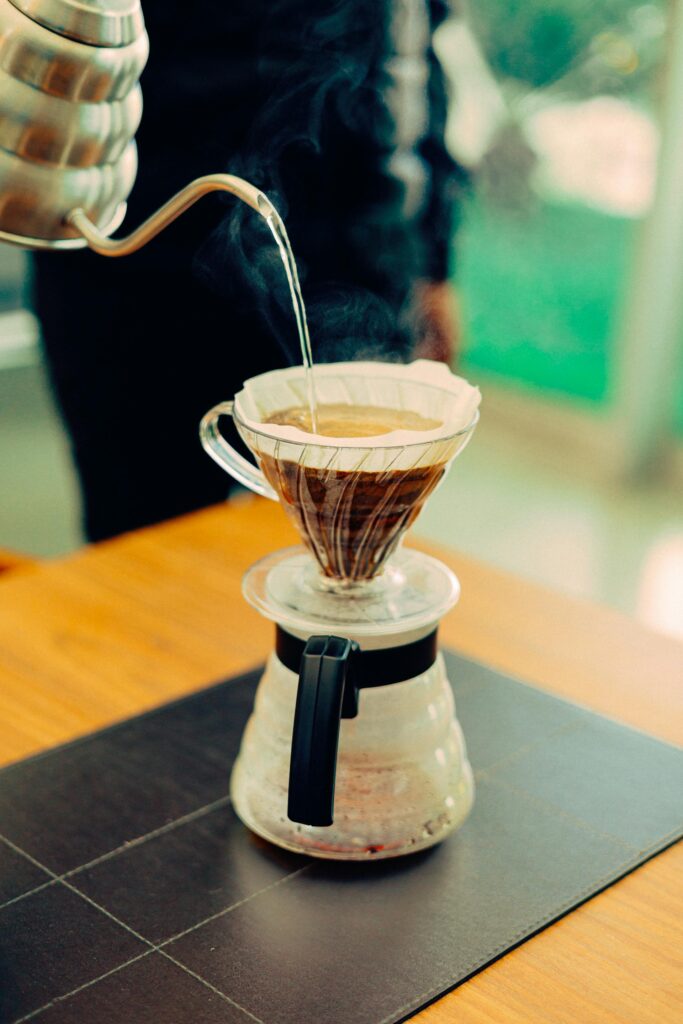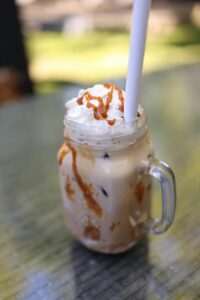Brewing coffee isn’t just about getting caffeine, but it’s a whole vibe. Some folks love the slow, hands-on ritual. Others just want to hit a button and go.
Manual vs. automatic brewing. Both make coffee, but the journey feels very different.
This guide breaks it all down. We’ll compare flavor, cost, time, and effort, so you can find the brew method that actually fits you.
Whether you’re a pour-over perfectionist or a press-a-button-and-run kind of person, this will help you decide.
What Are Manual Brewing Methods?
Manual brewing is exactly what it sounds like—you’re the barista. No buttons. No timers. Just you, hot water, ground coffee, and a bit of patience. It’s all about control and intention.
You choose the water temperature, the grind size, the pour rate—every step is in your hands.
Popular methods include the French Press, where you steep grounds in hot water and press down a plunger for a bold, full-bodied cup.
Then there’s the Pour Over (like Hario V60 or Chemex), known for clean, nuanced flavors that come from slow, circular pours.
The AeroPress adds pressure into the mix—think espresso vibes without the machine. Moka Pots brew strong, stovetop coffee that sits somewhere between espresso and drip.
And the Siphon, well, that one looks like a science experiment because vacuum pressure and heat combine for a smooth, theatrical brew.
Manual brewing isn’t just about making coffee but it’s a ritual. It slows you down.
It makes you notice the aroma, the bloom, the texture. It’s not always the fastest route to caffeine, but it might just be the most satisfying.
What Are Automatic Brewing Methods?
Automatic brewing is for the coffee lover who wants results without the ritual. You press a button, walk away, and return to a hot cup—no stopwatch, no pouring technique, no guesswork.
These machines handle the heavy lifting, making them ideal for busy mornings or multitaskers. Drip coffee makers are the classic example as you just fill the tank, add grounds, and you’re golden.
Single-serve pod machines like Keurig or Nespresso kick it up a notch with even less effort, though at a higher cost per cup.
Then there are super-automatic espresso machines that grind, tamp, brew, and even froth milk—all at once—making them a dream for those craving lattes without the café line.
Some models are programmable, letting you set your brew time the night before so you literally wake up to the smell of coffee. The key word here is convenience.
Automatic brewers sacrifice a bit of control for ease and speed, but for many folks, that’s a fair trade—especially when mornings feel like a sprint, not a stroll.
| Feature | Manual Brewing | Automatic Brewing |
|---|---|---|
| Control | High | Low to Moderate |
| Convenience | Low | High |
| Cost | Usually lower | Can be expensive |
| Time | Takes longer | Set and forget |
| Flavor Potential | Customizable | Consistent but limited |
| Learning Curve | Steeper | Beginner-friendly |
| Maintenance | Simple | Can be complex |
Pros and Cons of Manual Brewing
Pros:
- Full control over taste
- Budget-friendly
- Portable and compact
- Ritualistic and therapeutic
Cons:
- Requires attention and time
- Inconsistent results if rushed
- Learning curve for beginners
Pros and Cons of Automatic Brewing
Pros:
- One-button convenience
- Consistent results
- Great for busy mornings
- Some have smart features (timers, app control)
Cons:
- Less control over flavor
- Expensive for high-end models
- Less personal or “crafted” feel
- Repairs and cleaning can be a hassle
Which One Is Right for You?
Let’s cut to the chase because there’s no “one size fits all” when it comes to brewing coffee.
It really depends on your lifestyle, your taste, and how much you like (or hate) fiddling with kettles and grinders. Some folks love the ceremony of making coffee by hand.
Others just want caffeine without the drama. Here’s a quick guide to help you figure out where you land.
Choose manual if:
You actually enjoy the process. If brewing coffee feels more like therapy than a task, manual is your match. You like taking your time, tweaking the grind, adjusting your pour, experimenting with ratios.
You want control and you’re chasing flavor, not just function. Manual brewing is also great if you’re exploring new beans and want to taste all the notes and nuances.
Plus, it’s often more budget-friendly—no fancy machines required, just some gear and a bit of curiosity.
Choose automatic if:
You’re in a mad dash every morning. If your motto is “just give me coffee, fast,” an automatic brewer is your best friend. It’s built for speed and consistency.
No guesswork. No mess. Just reliable, hot coffee when you need it.
It’s also ideal if you’re brewing for more than just yourself—think family kitchens or busy office counters where time is tight and refills are frequent.
Automatic machines handle the grunt work so you don’t have to, and honestly, there’s no shame in that game.
Hybrid Options
Not ready to commit to just one style? No problem. Hybrid coffee makers give you that beautiful middle ground between craft and convenience.
You still get a say in the process but the machine helps out just enough to keep things smooth and easy.
Semi-Automatic Espresso Machines
These are perfect if you want to feel like a barista but don’t want to pull your hair out every morning. You grind the beans, tamp them down, and start the shot but the machine controls the pressure.
It’s a satisfying balance: you get hands-on control where it matters, and consistency where it counts. Great for home espresso lovers who want to level up without going fully manual.
Machines with “Manual Override”
Some automatic brewers now come with a manual override feature, letting you tweak the water flow, bloom time, or pause mid-brew.
This gives you room to experiment without ditching automation entirely. Think of it as your safety net because it lets you take the wheel when you want to, but still catches you if you mess up.
Automatic Pour-Over Machines
Love the taste of pour-over but don’t trust your morning brain to pull it off?
These machines do the precise water pouring for you—mimicking a perfect pour-over technique, just with no arm work required.
It’s ideal for those who appreciate the flavor clarity of pour-over but don’t want to stand there doing the swirl.
Best of Both Worlds
If you’re the type who wants great flavor and a smooth morning routine, hybrids check every box. They’re for the coffee drinker who enjoys the craft but also likes their sleep.
With hybrid brewers, you can geek out when you feel like it or just hit brew and carry on when life gets busy.
Cost & Maintenance Comparison
Let’s talk money and mess because no matter how great a coffee maker is, it still needs to fit your budget and not drive you nuts when it’s time to clean.
Manual and automatic brewers come with very different price tags and upkeep demands. Here’s what you need to know before swiping that card.
Initial Investment
Manual brewers are generally kinder on your wallet upfront. A solid French press, pour-over setup, or even an AeroPress can cost less than a single dinner out.
In contrast, automatic machines—especially espresso or pod-based models—can run into the hundreds or even thousands.
If you’re buying a super-automatic espresso machine, be ready to splurge. But remember, you’re paying for convenience, speed, and sometimes built-in tech.
Long-Term Costs
Here’s where things get sneaky. Manual brewers use basics: coffee, water, maybe paper filters. That’s it. The ongoing cost is minimal. With automatic machines, recurring expenses add up.
Pods or capsules (like Nespresso or Keurig) may seem cheap per use, but they’re pricey over time.
Plus, you’ll likely need replacement filters, descaling solutions, and more electricity to power larger models. That low-effort button starts to cost a bit more in the long run.
Cleaning Frequency and Ease
Manual brewers win here again. Most just need a quick rinse or a scrub. The French press has a few parts, but nothing crazy. Pour-over gear? A quick wash and it’s good to go.
Automatic brewers, though? Oh boy. Some need regular deep cleaning, descaling, and milk frother rinsing (if you’re into lattes).
Neglect it, and you’ll taste it, trust me. Cleaning these machines is doable, but it takes more effort and reminders.
Lifespan and Durability
Manual gear is usually built to last. No electronics. No pumps. Fewer things to break. Treat it right, and your pour-over setup could outlive your couch.
Automatic machines, on the other hand, have more moving parts, electronics, and wear-and-tear potential. Budget machines may only last a couple of years.
Higher-end ones can go longer, but repairs (when needed) can be pricey. So while automatics bring luxury and ease, they may also bring maintenance headaches down the road.
Final Thoughts
There’s no one-size-fits-all when it comes to brewing coffee. Some days you might crave the calm of a pour-over. Other days, the speed of a pod machine wins. And that’s perfectly okay.
The best method is the one that fits you—your routine, your taste, your vibe. Try both. Mix and match. Your coffee habits can evolve, just like your playlist.
Now it’s your turn. Manual or automatic? Or both? Drop your favorite brew method in the comments and let’s swap stories over a virtual cup!
FAQs
Is manual brewing better than automatic?
Not necessarily because it depends on what you value. Manual brewing gives you more control over flavor and strength. Automatic machines focus on speed and consistency.
One isn’t better than the other, just better for you.
Do automatic machines use more electricity?
Yes, especially models with built-in grinders, warmers, or milk steamers. Manual brewers don’t use power at all, unless you’re boiling water with an electric kettle.
Can I get café-style coffee with a manual brewer?
Absolutely. A well-done French press, AeroPress, or pour-over can rival your favorite coffee shop, if not beat it. It just takes practice and good beans.
Which is better for travel or camping?
Manual wins by a landslide. Devices like the AeroPress or a simple pour-over cone are light, portable, and don’t need electricity. Perfect for the great outdoors or hotel stays.
Are pods more expensive in the long run?
Yes. Pods may seem convenient, but per cup, they’re more expensive than using ground coffee. Plus, they generate more waste, both for your wallet and the environment.



